Text begins from here.


|
|
The many types of cameras has given rise to a wide variety of viewfinders.
Among optical viewfinders is the real-image viewfinder, which uses a separate
lens just for viewing, and the SLR-type viewfinder that uses the camera's lens
to allow direct confirmation of the image. Some digital cameras use an LCD
viewfinder to view the images captured by the CCD, while others use a larger
LCD monitor, or both. Each type has its advantages and the efficient use of both
is the mark of a skillful photographer. |

|
| A wide variety of viewfinders exist, each with its own strengths and weaknesses. |
| Method | Optical Real-Image Viewfinder | Optical SLR Viewfinder |
| Structure | 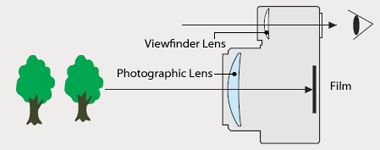 |
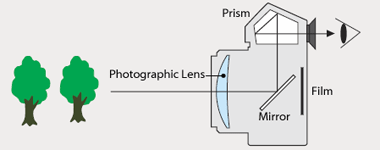 |
| Feature | Photographic lens and viewfinder lens are separate. | Image passes through the photographic lens and is reflected via a mirror or prism into the viewfinder. |
| Advantage |
- Moving subjects are easy to track.
- Consumes no electricity.
|
- Able to view and confirm the actual image that will be recorded to film.
- Moving subjects are easy to track.
- No parallax.
- Can use high-powered zoom lenses.
- Consumes no electricity.
|
| Disadvantage |
- Parallax occurs when subjects are too close to the camera.
- Cannot be used with high-powered zoom lenses.
|
- At the instant the photo is taken, the flipping up of the mirror creates an image blackout.
|
|
|
| With a lens-shutter camera, parallax is the difference between what the viewfinder sees and what the camera records, especially at close distances. This is caused by the separation between the viewfinder and the picture-taking lens. |
| Method | Electronic LCD Viewfinder (EVF) | Electronic LCD Monitor |
| Structure | 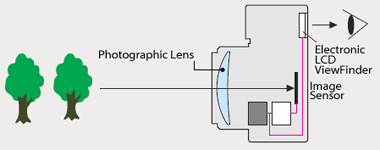 |
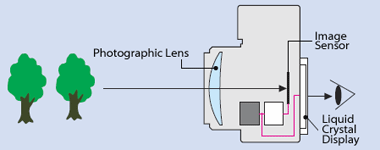 |
| Feature | The image that passes through the lens and is processed by the CCD is displayed on the EVF as digital data. | The image that passes through the lens and is processed by the CCD is displayed on the LCD monitor as digital data. |
| Advantage |
- Able to directly view the image recorded on the CCD.
- Viewfinder coverage is high, without parallax.
- Can be used with high-powered zoom lenses.
- Easy to view, even outdoors at midday.
|
- Able to see on a large screen the actual image recorded onto the CCD.
- The appearance of the image is close to the actual photo, making composition easy.
- Viewfinder coverage is high, without parallax.
- Can be used with high-powered zoom lenses.
|
| Disadvantage |
- Consumes electricity, though the amount is small.
|
- Difficult to view outdoors under bright conditions.
- Power consumption is high.
- Since viewing the monitor causes the elbow to be bent slightly outward when the picture is taken, hand-shake can easily occur.
|
 What is viewfinder coverage? What is viewfinder coverage? |
 What is viewfinder magnification? What is viewfinder magnification? |
||||
This indicates the percentage of the actual image recorded
on the film or CCD that can be seen in the viewfinder. |
This figure represents the ratio of the size of the actual image seen by the
naked eye to the size of the image seen in the viewfinder. |
||||
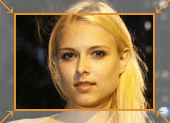 |
The wider the viewfinder coverage, the easier it is for the photographer to visualize the trimming amount. For example, if the viewfinder coverage is 80%, the remaining 20% will be cut off. | 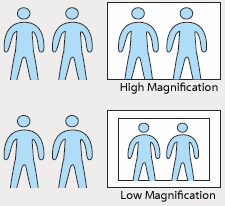 |
- If the size of the image seen by the naked eye and the size seen in the viewfinder are the same, the viewfinder magnification is said to be 1x.
- The higher the magnification, the easier it is to check the focus and other items.
*Viewfinder magnification is measured using a 50mm lens. |
||

|
Many digital cameras are equipped with both an electronic viewfinder (EVF) and an LCD monitor. You're likely to find it better to use each for different types of scenes. |
| Viewfinder Style | LCD monitor Style | ||||

|

|
||||
 |
 |
 |
 |
 |
 |
